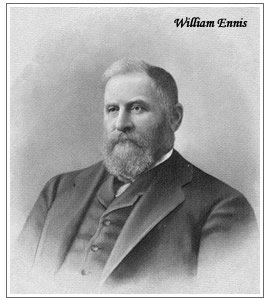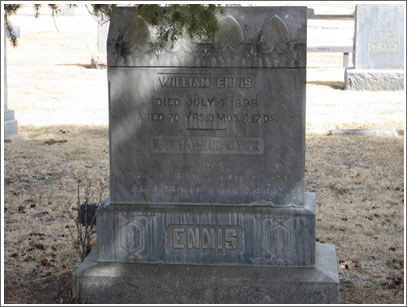Ever since I can remember I have known the story of my grandmother’s uncle, William Ennis, who left Ireland for America, founded the town of Ennis Montana, and was shot and killed.
I also remember the keen disappointment I felt as a child, with a taste for cowboy films, when I discovered that he had not been killed by Indians on horseback circling a wagon train, or in a shootout in the main street!
But time and distance had meant that no one in the family here in New Zealand was exactly sure what had happened.
The recent internet access to a number of sites containing newspaper archives rekindled my interest in William and the manner in which he met his death. William was the older brother of my great grandfather, David Ennis. William and David had left their home in County Down, Ireland, in the 1840s and 1850s for a life in the New World. They had obviously kept in touch with one another, William as he travelled around America, and David as he travelled first to the gold-fields of Australia and then on to New Zealand. The correspondence continued through the generations with my grandmother having a pen-friend in William’s granddaughter, Winifred Chowning. Although they were a generation apart, Grandmother and Winifred were a similar age as David had married late in life and his children were closer in age to his brother’s grandchildren.

The recent internet access to a number of sites containing newspaper archives rekindled my interest in William and the manner in which he met his death, and I took the opportunity to find out more about him and the events that led to his demise.
William was born on 17th March 1828, Saint Patrick’s Day, a significant date for the Irish. He was just 14 years old when he sailed for America in the company of his father who returned to the family in Ireland after a couple of years, leaving William living in Detroit with an uncle.
After a time working on the railroads, William eventually began a business moving freight and made a lot of money transporting supplies to the gold-fields of Montana. It was on one of these trips, when he needed fodder for his animals that he was directed to the Madison Valley not far from Virginia City. Here he found lush pastures, and never one to pass up a business opportunity; he made hay which he transported to Virginia City to sell. He laid claim to the land in the Madison Valley and built a cabin, eventually moving his family there. William continued his freighting business from there, and as the town which was to have his name grew up around him, he opened other businesses, eventually owing a general store, a livery stable and a post office of which he was the first postmaster, a role that was to be passed through another two generations of his family, covering a span of eighty-four years. In 1891 the Ennis family began a telegraph service linking the town of Ennis with the outside world. William’s daughter Jennie had taught herself Morse code and was licensed as the telegrapher.
On 18th June 1898, while William was in Virginia City on business, he was shot while standing talking on the street outside Madison House, the hotel where he was staying. The local newspaper, the Butte Weekly Miner, reported the shooting on June 23rd, under a headline banner that read
FATAL RESULT OF AN OLD FEUD
William Ennis Shot by Martin Peel at Virginia City – Both Men Old Timers
The story told how William was standing talking to a friend outside the Madison House Hotel in Virginia City when he was approached and shot in the chest by Martin Peel. Peel then walked up the main street to the Sheriff’s office and gave himself up. William was taken to his room in Madison House and his wounds were dressed and cared for by two local doctors. The paper supposed that the shooting was the result of an old grudge which existed between the two men. It is interesting that although at the time the story was printed in the paper William was still alive, the headline indicated that shooting was fatal and in the story it was suggested that he would not recover.
William died on 4th July 1898, American Independence Day. There were a number of newspaper reports of his death and funeral and they indicate that he lived for fifteen days after the shooting, without food of any kind.
An Obituary recorded:
The dead man was past his seventieth milestone and had laughed at the rigors and hardships of frontier life for 25 years. He had fought Indians on the plains and braved the dangers of the blazed trails of the west, to be shot down in his old age, without a moments warning, and without the shadow of a chance to defend himself or escape.
So, as a child I was not too far wrong in my imaginings of the life of William, he did fight Indians!
Now I knew the story of how William met his death, I began to wonder what had happened to his killer, Martin Peel.
The newspaper of 21st July 1898 recorded that Martin was charged with murder in the first degree. He pleaded not guilty. I could find little about the trial itself, but a report on 29th December 1898 indicated that Martin Peel was found guilty of murder in the first degree, and stated that this almost certainly meant death by hanging. On 18th March 1899 it was reported that he was sentenced to hang, and that his plea of insanity did not save him.
However I was unable to find any record in the online newspaper archives, which only covered the time up to 1900, of this sentence being carried out, nor could I find any record of his death around this time.
At this point I thought I would never find out what happened to Martin Peel, but through the internet I managed to make contact with a person who lived not far from Ennis who had access to later newspaper archives.
Using these we found that there was an appeal lodged against the conviction of Martin Peel which led to a retrial. At the second trial in 1900, he was found guilty of murder in the second degree and on 23rd June 1900 he was sentenced to fifteen years in the state penitentiary. The 1900 Federal Census, taken on 21st June, two days before the sentencing, shows Martin Peel as a prisoner at the same address as the Sheriff of Union Township, Madison County, Montana.

There were a number of newspaper reports of appeals by the prison physician requesting an early release for Martin Peel on the grounds of his continuing ill health, which were all denied. Martin Peel died in jail in November 1905. He was 73 years old.
There have been a number of possible motives for this murder suggested in various articles detailing the history of the local area, but after all this time we will never know the truth. In a paper entitled Trials of Martin Peel, presented to the 15th Annual History Conference of the Gallatin Historical Society in 2003, author Gary Forney suggests that from evidence presented at the two trials the most likely motive relates to the burning of a hall about a year earlier. The hall in question was originally built by public subscription, but at the time it burnt down it was owned in private partnership between William Ennis and another man. On the day following the fire, William’s son and some of his friends discovered footprints leading away from the fire, towards the home of Martin Peel. Rumours soon got around that Martin Peel had burnt the hall down, followed closely by rumours that the Ennis family were plotting to hang Peel in retaliation.
Whether or not there was any truth behind either of these rumours cannot be known. Martin Peel steadfastly maintained his innocence in the arson of the hall. Evidence presented at his trial showed that he took the threat of retaliation very seriously and that he had repeatedly contacted Llewellyn Callaway, the prosecuting attorney, seeking legal protection from William Ennis. However he, and others approached by Martin Peel did not take the supposed threat seriously and no action was taken. A neighbour testified that in the months prior to the shooting Peel seemed almost singularly focused on the thought that his life was in imminent danger. There was one witness who appeared at the trial who stated that he was approached by William’s son to join a group to discuss a plan to hang Martin Peel. However it appears that neither side called any other witnesses to corroborate or refute his story.
From what I have read it seems very possible that Martin Peel was suffering from the early stages of dementia, his deteriorating mental state was certainly made much of at the time of his second trial.
Perhaps the most fitting statement on the whole tragic affair was written by the former prosecuting attorney, Llewellyn Callaway who noted in his memoirs: “I think the truth is that Martin Peel, an irascible man, probably was influenced by irresponsible gossip from people who should have known better. Some of this gossip cost the lives of two men, both old timers, who should have lived and died in peace”
KiwiChris
© KiwiChris 2008
SOURCES
Newspapers:
Butte Weekly Miner
Helena Independent
Anaconda Standard
Salt Lake City Semi Weekly Tribune
Pioneer Trails and Trials, Madison County 1863-1920 Compiled by Madison County History Association Copyright 1976. Printed by Blue Print and Letter Company, Great Falls, Montana
Trials of Martin Peel by Gary Forney
Paper presented at the 15th Annual History Conference of the Gallatin Historical Society, November 8 2003